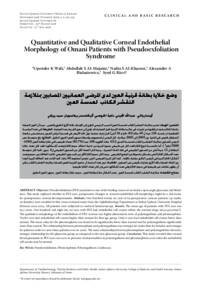Document
Quantitative and qualitative corneal endothelial morphology of Omani patients with pseudoexfoliation syndrome.
Contributors
Al-Mujaini, Abdullah S., Author
Al-Kharusiyah, Nadia S., Author
Bialasiewicz, Alexander A., Author
Rizvi, Syed G., Author
Other titles
وضع خلايا بطانة قرنية العين لدى المرضى العمانيين المصابين بمتلازمة التقشر الكاذب لعدسة العين
Publisher
College of Medicine, Sultan Qaboos University.
Gregorian
2008-11
Language
English
English abstract
Pseudoexfoliation (PEX) syndrome is one of the leading causes of secondary open angle glaucoma and blindness. This study explored whether in PEX eyes, preoperative changes in corneal endothelial cell morphology might be a risk factor for postoperative corneal decompensation. Methods: One hundred twenty six eyes of 69 preoperative cataract patients (43 males, 26 females) were enrolled in this cross-sectional study from the Ophthalmology Department at Sultan Qaboos University Hospital between 2003-2005. All patients were subjected to confocal biomicroscopy. Results: The mean age of patients with PEX eyes was 63.2 years. One hundred and eight (85.7%) eyes with PEX had endothelial cell counts within the normal range (1650-3500/mm²). The qualitative morphology of the endothelium of PEX corneas was highly abnormal in term of polymegathism and pleomorphism. Twelve eyes had endothelial cell counts higher than normal for that age group. Only 6 eyes had endothelial cell counts lower than normal. The mean value for the pleomorphism was found to be significantly lower than normal and for polymegathism significantly more than normal. The relationship between pleomorphism and polymegathism was stronger for males than for females and stronger for patients under 60 years than patients over 60 years. The same relationship between pleomorphism and polymegathism showed a stronger relationship for the glaucoma group as compared to the non-glaucoma group. Conclusion: This study revealed that corneal decompensation in PEX eyes can occur in presence of abnormalities in polymegathism and pleomorphism, even when the endothelial cell counts may be normal.
Member of
Resource URL
Arabic abstract
تعتبر متلازمة التقشر الكاذب لعدسة العين السبب الرئيسي المؤدي إلى الإصابة بالماء الأزرق الثانوي والعمى ، حيث أن العين المصابة بتلــك المتلازمـة وما يرافقها من تغيرات في خلايــا بطانة القرنية قبل العملية قد تؤدي إلى تدهور القرنية بعد العملية. الطريقة: في هذه الدراســة المقطعية تم دراســة 126 عينا ل 69 حالة (43 ذكرا و 26 أنثى) قبل إجراء عملية نزول الماء الأبيض في قســم أمراض العيون بمستشـفى جامعة السلطان قابوس في الفترة بين 2003 إلى 2005 ميلادية. كل المرضى تم فحصهم بواسطة مجهر العين الحيوي الدقيق. النتائج: بلغ متوسط عمر المرضى المصابين بمتلازمة التقشــر الكاذب لعدسـة العــين 2.63 عاما. أظهرت 108 عينا (%7.85 (تعدادا طبيعيـا في خلايا بطانة العين (1650- 3500/ملم² .( أما بالنســبة لنوع الخلايا فقد كان غير طبيعي بصورة كبيرة من ناحية اختلاف حجم الخلايا وتعدد أشـكالها. فقد كان تعداد خلايا البطانة ل 12 عينا أعلى من المستوى الطبيعي في تلك الفئة العمرية ، بينما كان التعداد أقل من المستوى الطبيعي ل6 عيون. كما كان متوسط تعدد أشــكال الخلايا أعلى بشــكل ملحوظ عن الوضع الطبيعي ، بينما كان حجم الخلايا أقل من المســتوى الطبيعي. كانت العلاقة بين حجم وتعدد أشكال الخلايا كبيرا في المرضى الذكور مقارنة بالإناث، كما كان كبيرا للمرضى الذين تتعدى أعمارهم 60 عاما. كما كانت هذه العلاقة كبيرة أيضا بين الفئة المصابة بالماء الأزرق مقارنة بالمرضى غير المصابين. الخلاصة: تبين هذه الدراسة أن تدهور القرنية للعين المصابة بمتلازمة التقشر الكاذب يمكن أن يظهر علامات غير طبيعية في حجم الخلايا وفي تعدد أشكالها حتى وان كان تعداد الخلايا طبيعيا
Category
Journal articles

